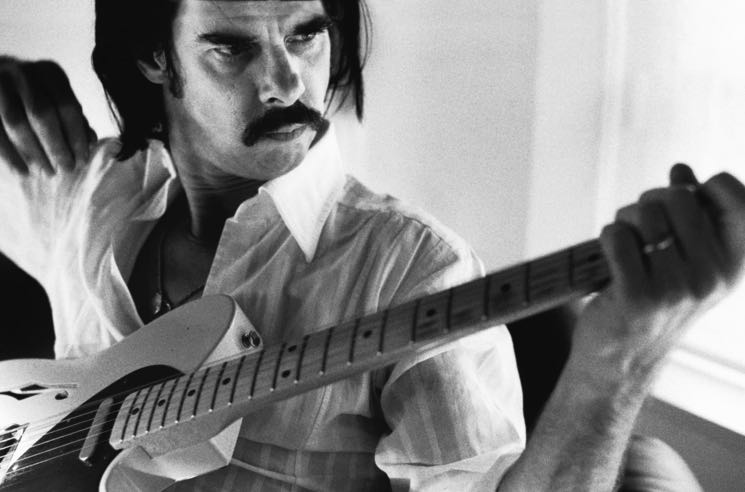In early performances with his first band, Nick Cave looked more like a pouty pop-punk teen idol than the man who would become one of alternative rock's most cherished songwriters. Contemporaries like Henry Rollins, Boss Hog/Pussy Galore's Jon Spencer and the Jesus Lizard's David Yow still speak highly of the distinguished Australian, but he's also inspired a crop of indie darlings who raid his lyrics and his wardrobe to construct their personas. You're as likely to hear his influence in a pigfuck screed as you are on a Starbucks playlist.
Perhaps it's fitting that someone with an affinity for tailored suits has been able to veer from fashionable to tasteless to timeless. Since the Boys Next Door changed their name to the Birthday Party, Cave has set himself apart with his violent lyricism and intense theatricality. After the group dissolved, he retained these traits (as well as a few key musicians) and formed Nick Cave and the Bad Seeds, his best-known project. The new band combined Cave's previous strengths with a more prominent fixation on blues, country and other traditional American musical forms. Still active after 30 years, the Bad Seeds hold post-punk's highest pedigree, and they've welcomed members of the Cramps, Teenage Jesus and the Jerks, Magazine and more into the flock.
Through it all, the band's leader has endured not just because of his songwriting prowess, but because he's a consummate performer. Cave likes to portray himself as a poet troubadour who pursues his muse during office hours, but his words would sink if he wasn't stagy enough to keep them buoyant. The singer's delivery has the power to make his lyrics campy, terrifying or archly ironic and sometimes all three at once.
This year may go down as one of Cave's most prolific. He released a score for the David Mackenzie film Hell or High Water with Dirty Three multi-instrumentalist and Bad Seed Warren Ellis in August, and the Bad Seeds dropped their latest album, Skeleton Tree, in September alongside a concert film, One More Time with Feeling. Cave calls the new material his most "catastrophic" work yet, but before you dive in, prepare yourself with our Essential Guide to punk's most contemplative, horny old man.
Essential Albums:
5. Nick Cave and the Bad Seeds
Murder Ballads
(1996)

It's baffling enough that after 20 years on rock's fringes, Nick Cave started selling enough records to achieve Top 10 status in the UK and earn an MTV Europe award nomination; the fact that he did so with Murder Ballads, an album that mixes traditional songs with original representations of the form is even more astounding.
Previous albums Let Love In and Henry's Dream retained the literature-inflected lyrics and requisite twang of other Bad Seeds albums, but songs like "Straight to You" and "Nobody's Baby Now" also showed that Cave wasn't afraid to adopt sweet pop melodies. "Henry Lee" and "Where the Wild Roses Grow" still maintain these elements, but their violent subject matter and old-fashioned musical accompaniment help them stay tantalizing instead of cloying. The gonzo perspectives in "The Curse of Millhaven" and "O'Malley's Bar" also give the singer plenty to sink their teeth into. Cave sneers through the former and vainly preens through the latter, while his rendition of "Stagger Lee" stays so close to the Big Stick version that Cave can go whole hog on its macho vulgarity.
4. Nick Cave and the Bad Seeds
Let Love In
(1994)

Murder Ballads was the Bad Seeds' most popular album, but it wasn't their poppiest. Since "The Ship Song" on The Good Son, Cave's ballads had gotten weepier, and the two albums that followed leaned more toward folk and rock than the Gothic punk found on the band's earliest albums.
Let Love In is the pinnacle of this pop period. The Bad Seeds lineup remained relatively static following 1992's Henry's Dream, which based its arrangements largely on acoustic instruments. Let Love In, on the other hand, relies heavily on organs and electric guitars. As a result, some of the album's best tracks are moody numbers with sparse rhythms, such as opener "Do You Love Me?" and the Milton-referencing "Red Right Hand." The band also lean into grittier rock on "Jangling Jack" and "Thirsty Dog," while "Loverman" and "Lay Me Low" also act as good barometers for new fans; if you find the former too silly and the latter overwrought, you may not be able to stomach Cave at his most excessive.
3. The Birthday Party
Junkyard
(1982)
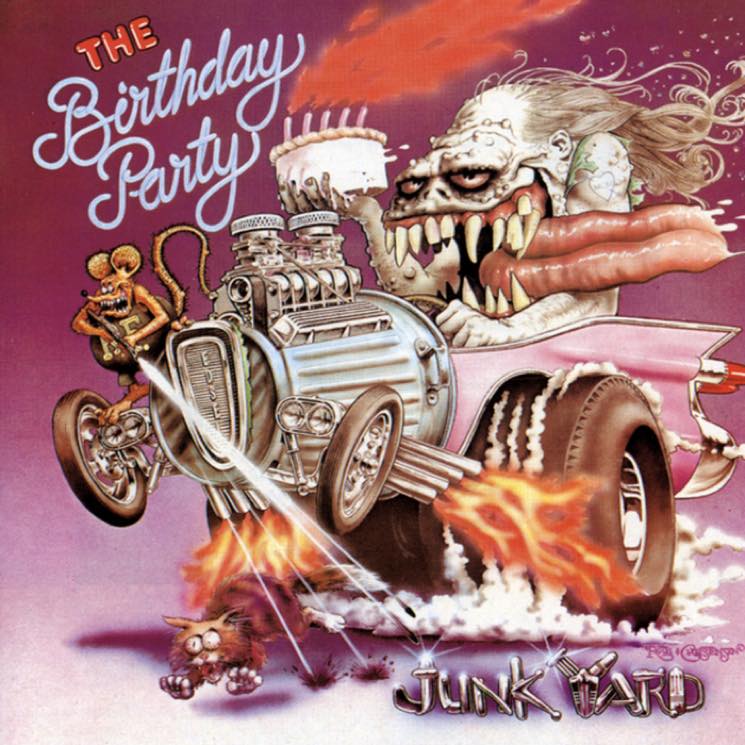
Watch live videos from the Birthday Party's final year together, and you'll find Cave wailing like an oversexed, chain-smoking version of Neil Gaiman's Morpheus behind bandmates who are either gyrating or on the nod. LP opener "She's Hit" is moody and mannered enough to fit in with other Gothic rock bands such as Siouxsie and the Banshees and labelmates Bauhaus, but Junkyard quickly devolves into the lewd and gloriously raucous mess its cover suggests.
Bassist Tracy Pew and drummer Phill Calvert bang out overbearing rhythms that are somehow both thrillingly sloppy ("Dead Joe") and incredibly precise ("Big Jesus Trash Can"). It's difficult to believe that two guitarists play on most songs, but that's because Rowland S. Howard and Mick Harvey favour either thin feedback or lacerating leads that sound like Public Image Ltd.'s Keith Levene. Lines often skip along behind the bass ("Hamlet [Pow Pow Pow]"), and the descending melody that opens "The Dim Locator" is practically obscene. Even Cave takes a different approach.
He would cover similar lyrical ground in the Bad Seeds, but he'd rarely trot out the throat-shredding shriek heard on "Junkyard" from this point forward.
2. Nick Cave and the Bad Seeds
Tender Prey
(1988)
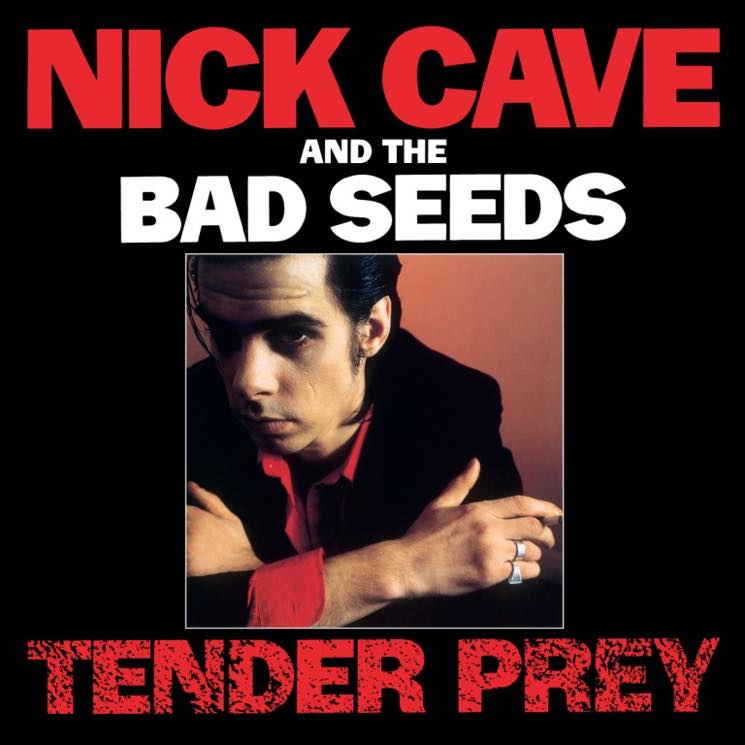
Bad Seeds albums have had more flamboyant beginnings — 1985's The Firstborn Is Dead starts with a thunderclap, for god's sake — but Tender Prey's "The Mercy Seat" announces itself in a way that few of his other openers manage. With its earth-shaking bass, flinty piano and a drumline that's practically a march, it lets listeners know that Cave and company are doubling down on their stark vision of Americana.
As a whole, Tender Prey serves a similar purpose. It's a culmination of everything the Bad Seeds had done to date, but everything is amplified and concentrated. The production is clearer than ever before, and the band added keyboardist Roland Wolf and Cramps guitarist Kid Congo Powers after Your Funeral… My Trial, resulting in more expressive arrangements. As a result, Cave was able to cover new ground with familiar subject matter.
"Up Jumped the Devil" is another song about outlaw living, but slinkier bass and piano parts lend it a more sinister air, especially when coupled with lines about "nailing (a) face to the hitching fence." Indeed, Tender Prey was released a little over a year after the covers album Kicking Against the Pricks, and it feels like Cave has gone from singing standards to trying to write his own. Drenched in Old Testament imagery, "Mercy" powerfully equates faith with submission, and the impressionistic lyrics on "The Mercy Seat," about a man condemned to death, found further legitimacy when Johnny Cash covered it for American III: Solitary Man in 2000. Cave had long put a strong emphasis on songwriting, but this is the first Bad Seeds album that matches his ambition.
1. Nick Cave and the Bad Seeds
Abattoir Blues/The Lyre of Orpheus
(2004)

It's easy to forget now, but Abattoir Blues/The Lyre of Orpheus could have been terrible. A double album on the heels of his two most bloated records could have been signals Cave was stuck following his worst instincts. The band also lost founding guitarist and Einstürzende Neubauten mastermind Blixa Bargeld after Nocturama, and when you lose the guy who records harsh industrial albums inside freeway pillars, it's never a good sign.
Yet Abattoir Blues/The Lyre of Orpheus is Nick Cave and the Bad Seeds' most vital and varied effort, offering a spry enthusiasm that the band hadn't put to tape since The Firstborn Is Dead. Abattoir Blues opener "Get Ready for Love" dive-bombs the listener with energetic gospel and "There She Goes My Beautiful World" moves at a frenzied funk pace.
The only signs of Cave as self-serious balladeer come late on The Lyre of Orpheus, but he seems set on both honouring and skewering his past persona. Instead of Milton, he references Sappho and W. H. Auden before admitting that these poets make his pursuers "slowly die of boredom."
Any remaining pomposity gets wrung out in absurd twists. On "Abattoir Blues," he describes how his "moral code got jammed" before solemnly intoning about waking up "with a frappuccino in [his] hand." Nick Cave and the Bad Seeds spent 20 years posing and trying on traditional personas, so it's fitting that the band's best record would be the one that finally gets playful with this pageantry.
What to Avoid:
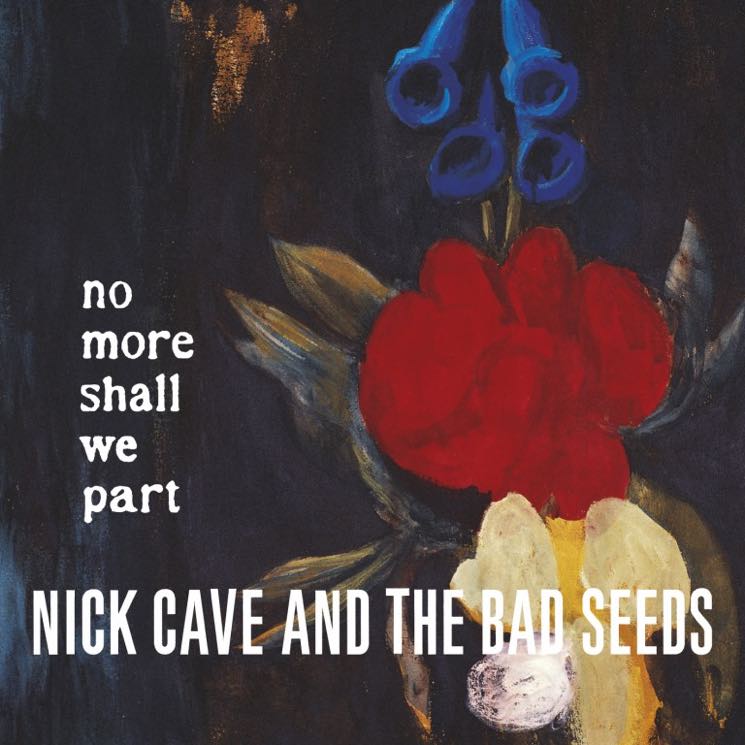
The Boys Next Door's 1979 album Door, Door isn't entirely unpleasant, but its Buzzcocks-indebted zippiness feels out of place next to Cave's more dramatic work. "The Voice" has the frantic rhythms that the band would later push to the fore, and a few acts remember Rowland S. Howard's "Shivers" fondly, but aside from those tracks, the group mostly cribs from other post-punk bands, doing little to set themselves apart from the pack.
Cave hit his nadir with 2001's No More Shall We Part and 2003's Nocturama. Coming on the heels of the sombre and self-pitying The Boatman's Call, Cave leans into his worst habits as a singer-songwriter here, resulting in a pair of albums that are flatulent and tedious. Drunk on the Pope's Blood/The Agony Ecstasy, a 1982 split EP with no-wave icon Lydia Lunch, is redundant for different reasons; three of its four Birthday Party tracks can be found on live albums and the other one is a cover of the Stooges' "Loose," so it's best left to completist collectors.
The 2014 pseudo-documentary 20,000 Days on Earth seems like it would be a good introduction to Cave's persona, but the singer is a relentless self-mythologist, which prevents directors Iain Forsyth and Jane Pollard from catching a clear look at him. Other fans may get something out of it, but it's confusing for beginners and frustratingly vague for intermediates.
Further Listening:
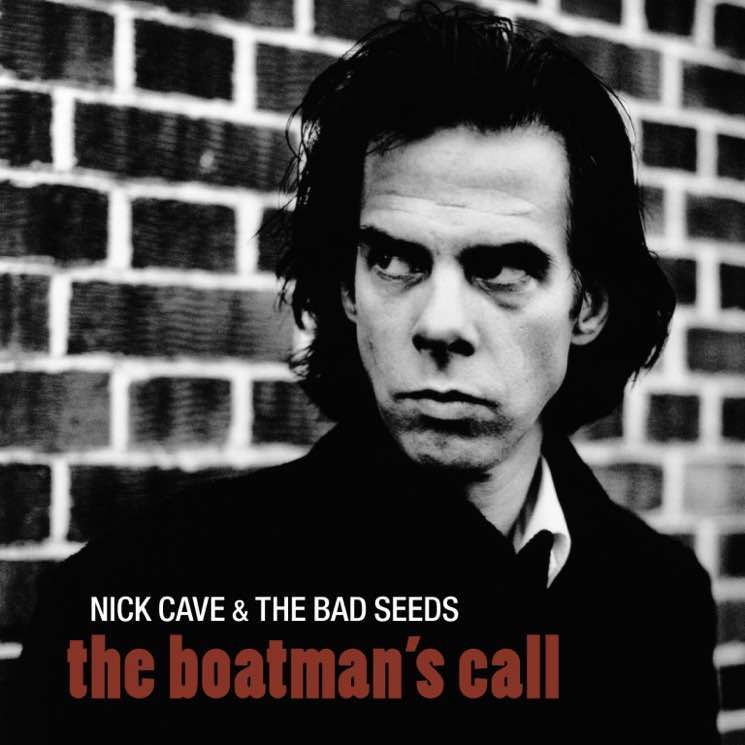
What you liked best from the Essential Albums will determine where you should go next. Fans of Let Love In's accessible rock would do well to move on to The Good Son (1990) and Henry's Dream (1992). If Murder Ballads' "Henry Lee" and "Where the Wild Roses Grow" strike your fancy, try 1997's The Boatman's Call, which shows off Cave's sombre singer-songwriter side — though in the tradition of many breakup albums, it runs rather long and can get pretty self-pitying.
Tender Prey devotees will want to pick up 1985's The Firstborn is Dead and 1986's Kicking Against the Pricks and Your Funeral… My Trial for more roots-based punk. Those craving the loose lyrics and classic-rock sound of Abattoir Blues/The Lyre of Orpheus should find Dig, Lazarus, Dig!!! (2008) immediately, as it's even more lewd and acid-fried than its predecessor. The two Grinderman albums, Grinderman (2007) and Grinderman 2 (2010), get even looser, despite the latter being the best-produced Cave record.
You'll have to work your way up to Cave's 1984 Bad Seeds debut, From Her to Eternity. His first album as a bandleader is languid, lacking both the Birthday Party's dynamism and the cohesiveness of later Bad Seeds releases, but it contains several excellent songs (the title track, "Cabin Fever!" and a cover of Leonard Cohen's "Avalanche") and establishes the Southern Gothic imagery that underlies much of Cave's work through the new millennium.
If you want to know more about the Birthday Party, their reissued 1980 self-titled album (complete with the 1979 Hee-Haw EP) and 1981's Prayers on Fire feature more orderly rhythms and melodic vocals than their 1982 opus, but still showcase Howard and Harvey's jagged guitar parts. Released after Junkyard but before the Birthday Party broke up, the 1983 Mutiny! and Bad Seed EPs hint at Cave's next project on songs like "Wildworld," "Deep in the Woods" and "Jennifer's Veil" (though the former's artwork also features a tasteless swastika).
If you want to understand where Cave and company currently stand, you'll need to hear 2013's Push the Sky Away. Longtime Bad Seed Warren Ellis helped Cave compose the music, resulting in subdued instrumentation and solemn vocals. The album meandered and lost focus at times, but the group's next album would use a similar sonic template to achieve clarity in the face of unfathomable trauma.
Cave's son Arthur died during Skeleton Tree's (2016) recording, and its influence is inescapable. In the essential companion documentary One More Time with Feeling, the songwriter admitted that he could no longer represent his outlook through linear narratives. On "Girl in Amber," he repeats himself like a skipping tape, unable to read the line straight. "I Need You" dwells upon imagery as if trying to make it real by force of will, while vocal harmonies wail or sigh resignedly behind Cave. Songs resist cause or clear resolution, entering abruptly (the start of "Jesus Alone") or folding into a textural whole ("Magneto" and "Anthrocene"). When the title track ends the album on a note of resigned acceptance, it's clear that Cave has delivered the most nuanced, expressive album of his career so far.
Finally, fans should explore Cave and Warren Ellis's soundtrack work, as it often informs their output with the Bad Seeds. The original motion picture soundtrack to 2012's Lawless is the duo's most accessible work, featuring bluegrass covers of rock and blues standards, but scores for The Proposition (2012) and The Assassination of Jesse James by the Coward Robert Ford (2007) offer a more pastoral feeling that better suits their most recent work with the Bad Seeds. Those looking for a summary should seek out the 2009 White Lunar compilation, which offers a good sense of the Cave/Ellis house style.
Perhaps it's fitting that someone with an affinity for tailored suits has been able to veer from fashionable to tasteless to timeless. Since the Boys Next Door changed their name to the Birthday Party, Cave has set himself apart with his violent lyricism and intense theatricality. After the group dissolved, he retained these traits (as well as a few key musicians) and formed Nick Cave and the Bad Seeds, his best-known project. The new band combined Cave's previous strengths with a more prominent fixation on blues, country and other traditional American musical forms. Still active after 30 years, the Bad Seeds hold post-punk's highest pedigree, and they've welcomed members of the Cramps, Teenage Jesus and the Jerks, Magazine and more into the flock.
Through it all, the band's leader has endured not just because of his songwriting prowess, but because he's a consummate performer. Cave likes to portray himself as a poet troubadour who pursues his muse during office hours, but his words would sink if he wasn't stagy enough to keep them buoyant. The singer's delivery has the power to make his lyrics campy, terrifying or archly ironic and sometimes all three at once.
This year may go down as one of Cave's most prolific. He released a score for the David Mackenzie film Hell or High Water with Dirty Three multi-instrumentalist and Bad Seed Warren Ellis in August, and the Bad Seeds dropped their latest album, Skeleton Tree, in September alongside a concert film, One More Time with Feeling. Cave calls the new material his most "catastrophic" work yet, but before you dive in, prepare yourself with our Essential Guide to punk's most contemplative, horny old man.
Essential Albums:
5. Nick Cave and the Bad Seeds
Murder Ballads
(1996)

It's baffling enough that after 20 years on rock's fringes, Nick Cave started selling enough records to achieve Top 10 status in the UK and earn an MTV Europe award nomination; the fact that he did so with Murder Ballads, an album that mixes traditional songs with original representations of the form is even more astounding.
Previous albums Let Love In and Henry's Dream retained the literature-inflected lyrics and requisite twang of other Bad Seeds albums, but songs like "Straight to You" and "Nobody's Baby Now" also showed that Cave wasn't afraid to adopt sweet pop melodies. "Henry Lee" and "Where the Wild Roses Grow" still maintain these elements, but their violent subject matter and old-fashioned musical accompaniment help them stay tantalizing instead of cloying. The gonzo perspectives in "The Curse of Millhaven" and "O'Malley's Bar" also give the singer plenty to sink their teeth into. Cave sneers through the former and vainly preens through the latter, while his rendition of "Stagger Lee" stays so close to the Big Stick version that Cave can go whole hog on its macho vulgarity.
4. Nick Cave and the Bad Seeds
Let Love In
(1994)

Murder Ballads was the Bad Seeds' most popular album, but it wasn't their poppiest. Since "The Ship Song" on The Good Son, Cave's ballads had gotten weepier, and the two albums that followed leaned more toward folk and rock than the Gothic punk found on the band's earliest albums.
Let Love In is the pinnacle of this pop period. The Bad Seeds lineup remained relatively static following 1992's Henry's Dream, which based its arrangements largely on acoustic instruments. Let Love In, on the other hand, relies heavily on organs and electric guitars. As a result, some of the album's best tracks are moody numbers with sparse rhythms, such as opener "Do You Love Me?" and the Milton-referencing "Red Right Hand." The band also lean into grittier rock on "Jangling Jack" and "Thirsty Dog," while "Loverman" and "Lay Me Low" also act as good barometers for new fans; if you find the former too silly and the latter overwrought, you may not be able to stomach Cave at his most excessive.
3. The Birthday Party
Junkyard
(1982)

Watch live videos from the Birthday Party's final year together, and you'll find Cave wailing like an oversexed, chain-smoking version of Neil Gaiman's Morpheus behind bandmates who are either gyrating or on the nod. LP opener "She's Hit" is moody and mannered enough to fit in with other Gothic rock bands such as Siouxsie and the Banshees and labelmates Bauhaus, but Junkyard quickly devolves into the lewd and gloriously raucous mess its cover suggests.
Bassist Tracy Pew and drummer Phill Calvert bang out overbearing rhythms that are somehow both thrillingly sloppy ("Dead Joe") and incredibly precise ("Big Jesus Trash Can"). It's difficult to believe that two guitarists play on most songs, but that's because Rowland S. Howard and Mick Harvey favour either thin feedback or lacerating leads that sound like Public Image Ltd.'s Keith Levene. Lines often skip along behind the bass ("Hamlet [Pow Pow Pow]"), and the descending melody that opens "The Dim Locator" is practically obscene. Even Cave takes a different approach.
He would cover similar lyrical ground in the Bad Seeds, but he'd rarely trot out the throat-shredding shriek heard on "Junkyard" from this point forward.
2. Nick Cave and the Bad Seeds
Tender Prey
(1988)

Bad Seeds albums have had more flamboyant beginnings — 1985's The Firstborn Is Dead starts with a thunderclap, for god's sake — but Tender Prey's "The Mercy Seat" announces itself in a way that few of his other openers manage. With its earth-shaking bass, flinty piano and a drumline that's practically a march, it lets listeners know that Cave and company are doubling down on their stark vision of Americana.
As a whole, Tender Prey serves a similar purpose. It's a culmination of everything the Bad Seeds had done to date, but everything is amplified and concentrated. The production is clearer than ever before, and the band added keyboardist Roland Wolf and Cramps guitarist Kid Congo Powers after Your Funeral… My Trial, resulting in more expressive arrangements. As a result, Cave was able to cover new ground with familiar subject matter.
"Up Jumped the Devil" is another song about outlaw living, but slinkier bass and piano parts lend it a more sinister air, especially when coupled with lines about "nailing (a) face to the hitching fence." Indeed, Tender Prey was released a little over a year after the covers album Kicking Against the Pricks, and it feels like Cave has gone from singing standards to trying to write his own. Drenched in Old Testament imagery, "Mercy" powerfully equates faith with submission, and the impressionistic lyrics on "The Mercy Seat," about a man condemned to death, found further legitimacy when Johnny Cash covered it for American III: Solitary Man in 2000. Cave had long put a strong emphasis on songwriting, but this is the first Bad Seeds album that matches his ambition.
1. Nick Cave and the Bad Seeds
Abattoir Blues/The Lyre of Orpheus
(2004)

It's easy to forget now, but Abattoir Blues/The Lyre of Orpheus could have been terrible. A double album on the heels of his two most bloated records could have been signals Cave was stuck following his worst instincts. The band also lost founding guitarist and Einstürzende Neubauten mastermind Blixa Bargeld after Nocturama, and when you lose the guy who records harsh industrial albums inside freeway pillars, it's never a good sign.
Yet Abattoir Blues/The Lyre of Orpheus is Nick Cave and the Bad Seeds' most vital and varied effort, offering a spry enthusiasm that the band hadn't put to tape since The Firstborn Is Dead. Abattoir Blues opener "Get Ready for Love" dive-bombs the listener with energetic gospel and "There She Goes My Beautiful World" moves at a frenzied funk pace.
The only signs of Cave as self-serious balladeer come late on The Lyre of Orpheus, but he seems set on both honouring and skewering his past persona. Instead of Milton, he references Sappho and W. H. Auden before admitting that these poets make his pursuers "slowly die of boredom."
Any remaining pomposity gets wrung out in absurd twists. On "Abattoir Blues," he describes how his "moral code got jammed" before solemnly intoning about waking up "with a frappuccino in [his] hand." Nick Cave and the Bad Seeds spent 20 years posing and trying on traditional personas, so it's fitting that the band's best record would be the one that finally gets playful with this pageantry.
What to Avoid:

The Boys Next Door's 1979 album Door, Door isn't entirely unpleasant, but its Buzzcocks-indebted zippiness feels out of place next to Cave's more dramatic work. "The Voice" has the frantic rhythms that the band would later push to the fore, and a few acts remember Rowland S. Howard's "Shivers" fondly, but aside from those tracks, the group mostly cribs from other post-punk bands, doing little to set themselves apart from the pack.
Cave hit his nadir with 2001's No More Shall We Part and 2003's Nocturama. Coming on the heels of the sombre and self-pitying The Boatman's Call, Cave leans into his worst habits as a singer-songwriter here, resulting in a pair of albums that are flatulent and tedious. Drunk on the Pope's Blood/The Agony Ecstasy, a 1982 split EP with no-wave icon Lydia Lunch, is redundant for different reasons; three of its four Birthday Party tracks can be found on live albums and the other one is a cover of the Stooges' "Loose," so it's best left to completist collectors.
The 2014 pseudo-documentary 20,000 Days on Earth seems like it would be a good introduction to Cave's persona, but the singer is a relentless self-mythologist, which prevents directors Iain Forsyth and Jane Pollard from catching a clear look at him. Other fans may get something out of it, but it's confusing for beginners and frustratingly vague for intermediates.
Further Listening:

What you liked best from the Essential Albums will determine where you should go next. Fans of Let Love In's accessible rock would do well to move on to The Good Son (1990) and Henry's Dream (1992). If Murder Ballads' "Henry Lee" and "Where the Wild Roses Grow" strike your fancy, try 1997's The Boatman's Call, which shows off Cave's sombre singer-songwriter side — though in the tradition of many breakup albums, it runs rather long and can get pretty self-pitying.
Tender Prey devotees will want to pick up 1985's The Firstborn is Dead and 1986's Kicking Against the Pricks and Your Funeral… My Trial for more roots-based punk. Those craving the loose lyrics and classic-rock sound of Abattoir Blues/The Lyre of Orpheus should find Dig, Lazarus, Dig!!! (2008) immediately, as it's even more lewd and acid-fried than its predecessor. The two Grinderman albums, Grinderman (2007) and Grinderman 2 (2010), get even looser, despite the latter being the best-produced Cave record.
You'll have to work your way up to Cave's 1984 Bad Seeds debut, From Her to Eternity. His first album as a bandleader is languid, lacking both the Birthday Party's dynamism and the cohesiveness of later Bad Seeds releases, but it contains several excellent songs (the title track, "Cabin Fever!" and a cover of Leonard Cohen's "Avalanche") and establishes the Southern Gothic imagery that underlies much of Cave's work through the new millennium.
If you want to know more about the Birthday Party, their reissued 1980 self-titled album (complete with the 1979 Hee-Haw EP) and 1981's Prayers on Fire feature more orderly rhythms and melodic vocals than their 1982 opus, but still showcase Howard and Harvey's jagged guitar parts. Released after Junkyard but before the Birthday Party broke up, the 1983 Mutiny! and Bad Seed EPs hint at Cave's next project on songs like "Wildworld," "Deep in the Woods" and "Jennifer's Veil" (though the former's artwork also features a tasteless swastika).
If you want to understand where Cave and company currently stand, you'll need to hear 2013's Push the Sky Away. Longtime Bad Seed Warren Ellis helped Cave compose the music, resulting in subdued instrumentation and solemn vocals. The album meandered and lost focus at times, but the group's next album would use a similar sonic template to achieve clarity in the face of unfathomable trauma.
Cave's son Arthur died during Skeleton Tree's (2016) recording, and its influence is inescapable. In the essential companion documentary One More Time with Feeling, the songwriter admitted that he could no longer represent his outlook through linear narratives. On "Girl in Amber," he repeats himself like a skipping tape, unable to read the line straight. "I Need You" dwells upon imagery as if trying to make it real by force of will, while vocal harmonies wail or sigh resignedly behind Cave. Songs resist cause or clear resolution, entering abruptly (the start of "Jesus Alone") or folding into a textural whole ("Magneto" and "Anthrocene"). When the title track ends the album on a note of resigned acceptance, it's clear that Cave has delivered the most nuanced, expressive album of his career so far.
Finally, fans should explore Cave and Warren Ellis's soundtrack work, as it often informs their output with the Bad Seeds. The original motion picture soundtrack to 2012's Lawless is the duo's most accessible work, featuring bluegrass covers of rock and blues standards, but scores for The Proposition (2012) and The Assassination of Jesse James by the Coward Robert Ford (2007) offer a more pastoral feeling that better suits their most recent work with the Bad Seeds. Those looking for a summary should seek out the 2009 White Lunar compilation, which offers a good sense of the Cave/Ellis house style.
